Nature Trail
Corals...
Colourful creatures underwater:
When
you hear the word corals, what comes to your mind most probably would be
the inanimate stone-like formations you may come across on the beach, or
see at special places such as in Coral Gardens.
|
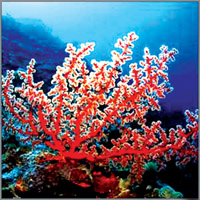
Red Fan Coral |
Those corals are the dead remains of the live corals we focus on
today. Some of you may have not even been aware that corals are a group
of animals called Cnidaria pronounced (with a silent 'c') which includes
sea anemones and jelly fish. The powerful battery of stinging cells,
which could fire tiny, poisonous threads called cnidae, are responsible
for this group being so named.
The cnidae or threads are often spiky or barbed, and even though a
single sting may not be of very little effect, thousand such cnidae
working together can become a powerful weapon for defence against
predators and to catch prey.
Even though cnidarians have no proper organs or a true circulatory
system, they do have a simple nerve network which places them on a
higher evolutionary scale than sponges, but on a lower one than worms.
|
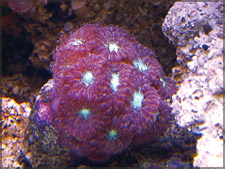 
Pineapple Corals |
If you have ever seen live corals, you may definitely find it hard to
believe that they are actually a group of animals that need food to
survive, and not some kind of marine plant life which moves because of
the ocean currents.
In fact, all cnidarians, though outwardly different from one to
another, have at the most basic level a mouth surrounded by tentacles.
It is with the aid of these tentacles that they catch food particles
needed for their survival. However, one characteristic corals that live
in cold water do not share with corals that live in warmer climes, is
the presence of algae in their tissues.
In the tropics, the corals use the algae to produce nutrients through
photosynthesis. If you are unaware what photosynthesis is, it is the
process by which the energy of sunlight is used by organisms to
synthesis (combine elements into a whole) carbohydrates from carbon
dioxide and water. This is a valuable supplement to the particles of
food that the corals catch with their tentacles from the flowing water.
|

Staghorn Corals |
Corals generally live in colonies, a mass of polyps (simple organisms
with a tube-shaped body) joined together in single firm structure. Most
often the structures are of intricate form, such as in the sea fans. In
less sunny waters or in deeper waters, corals usually live solitary
lives.
All corals can be split into three groups - hard corals, soft corals
and sea fans. The hard corals are considered to be reef building
animals. They have stony skeletons made almost completely of calcium
carbonate. It is this hard, but slow growing structure that provides the
soft polyp of the coral which is vulnerable (easily harmed), a safe
place to withdraw its tentacles when faced
|
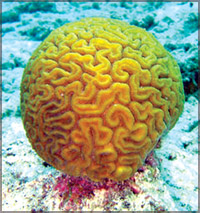
Brain Coral |
with danger.
Even though the majority of hard corals live in colonies, some, like
the cup corals, are solitary creatures. Cup corals live in closely
packed groups forming pseudo (resembling or imitating) colonies.
The Devonshire cup coral (Caryophyllia smithii) is a solitary coral
which at first glance could be mistaken for a sea anemone. It is a true
coral with a hard ribbed skeleton and is about 1.5 cm high and 2.5 cm -
3 cm in diameter (height is always less than the diameter). It has less
than 80 tentacles organised in three circles.
Each tentacle has a distinct transparent whitish knob at the end. It
is variable in colour. The soft part of the body and tentacles which
project from the body (from the skeleton), when undisturbed, range from
green, to yellow, to red in jewel-like colours.
Devonshire cup corals could be found attached to rocks and other hard
structures in depths of 15-100 metres. Often these creatures are home to
a variety of small barnacles which are not parasitic.
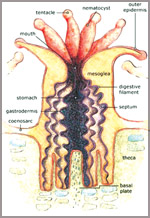 Sunset
cup corals (Heptosammia pruvotic), another stunning coral found in the
British Isles, is confined to the south-west part of the isles. It is
also found in Brittany, Portugal, Channel Isles, North-East Atlantic and
widely in the Mediterranean. Like all cup corals, they are solitary, but
their pseudo colonies may comprise from 10 individuals to several
hundred. Sunset
cup corals (Heptosammia pruvotic), another stunning coral found in the
British Isles, is confined to the south-west part of the isles. It is
also found in Brittany, Portugal, Channel Isles, North-East Atlantic and
widely in the Mediterranean. Like all cup corals, they are solitary, but
their pseudo colonies may comprise from 10 individuals to several
hundred.
The skeleton of the Sunset cup coral is porous. The Sunset cup corals
reach a height of about 60mm and the calyx (cup-like cavity or
structure) is up to 17mm in diameter.
They have about 96 tentacles.
They grow on shady rock faces, facing away from prevailing winds,
typically in caves and gullies or under overhangers.
It has been found that this slow growing coral can live over 100
years old, but reproduction is infrequent. It is
|
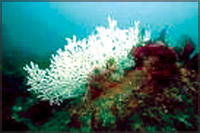
White Fan Coral |
listed as a rare species in UK.
Another striking cup coral in the hard coral group is the Orange cup
coral found in British Colombia to Baja California.
It makes its own outer skeleton the cup-like limestone base
underneath. It attaches its limestone skeleton to a rock and is set for
life. Like all corals, cup corals too eat small animals and organic
particles. Cup corals which prefer solitary lives take refuge in their
'cup.'
Soft corals belong to a subclass called Octocorals because each of
their polyps has eight tentacles. They are soft and flexible with no
hard skeletons.
Soft corals form a gelatinous mass supported by tiny calcareous
threads. The tentacles grow from the body and they collect particles of
food from the water column to feed the entire colony.
|
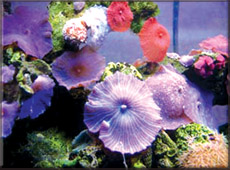
Mushroom Corals |
Of the soft corals, the largest corals are commonly known as
Deadman's fingers (Alcyonium digitatum). They resemble a dead person's
fingers when the polyps are completely retracted.
They live in colonies. Each colony can grow up to 25 cm long. The
polyps are always translucent white. Sometimes they grow so thickly that
it turns the underwater walls and cliffs into while fluffs.
The Pineapple coral is a small species. The polyps form a flat
honeycomb pattern and the colony as a whole forms a large dome-shaped
structure. Usually the polyps are green or brown in colour but some can
be orange or red in colour. Pineapple corals feed at night by extending
their translucent tentacles.
Brain corals are another type of coral. There are several varieties
of Brain corals found throughout the world. It
|
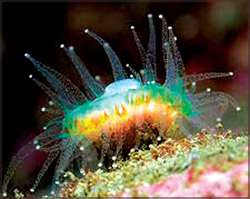
Devonshire Cup Coral |
is the brain-like ridges that cross their surface which has
given this
|
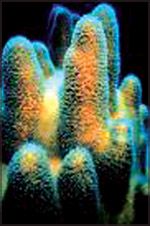
Pillar Corals |
species of coral its name.
The smooth brain coral grows in a large dome-shaped structure about
four feet in diametre. It is common in the Caribbean and Florida up to
the Bahamas.
Torch corals are fascinating. They are a beautifully coloured species
with a candy-like appearance and in fact are also known as the candycane
corals. Brown in colour with yellow stripes, the polyps have neon green
insides that give them the name torch corals.
They often live in small, tight clusters, and are nocturnal, like the
pineapple corals. These too feed at night, using their delicate
tentacles.
****
Fact file
* Corals date back in the fossil records to at least the Cambrian
period (over 500 million years ago). However, fossils are extremely rare
until the Ordovician period (100 million years later).
* Most cup corals have porous skeletons and some are the size of a
thimble.
* A cup coral larva crawls on the rocky surface before settling down,
to find a suitable place to cement itself.
* Corals with eight tentacles are called Octocorallia or Alcyonaria
and those with more than eight, in a multiple of six are called
hexacorallia or Zoantharia.
* Corals are highly sensitive to environmental changes. Scientists
claim that over 50 per cent of the coral reefs in the world may be
destroyed by the year 2030.
* A coral structure is usually composed of hundreds of thousands of
tiny animals or polyps growing together as a colony.
* Some coral varieties in the hard and soft coral groups are Pillar
corals, Pineapple corals, Moon corals, Torch or Candycane corals,
Mushroom corals, Staghorn corals. |
